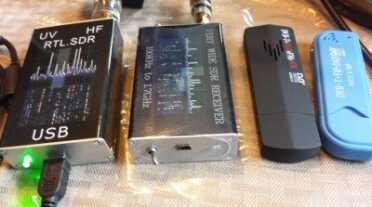
These are the models of basic Software Defined Radio (SDR) I have tried. For the regular dongle, which covers 100mhz-1.7ghz, the blue one seems to be the latest, with an updated tuner chip. The two blocks on the left include an Up Converter to be able to tune below 100mhz, in the HF bands used by Hams. the only difference between the two seems to be that switch that is absent from the less expensive one but it seems to work just as good without the switch.
Resources:
Basic blue dongle (820T2 chip)
Basic black dongle
Dongle with Up Converter no switch $53
Dongle with Up Converter w/switch $70
NooElec Up Converter (Ebay)
NooElec Website (Ham it Up, 9:1 Balun, Isolation Boxes)
Key Information:
Mr. Carl Laufer’s website: https://www.rtl-sdr.com/.
His Book:The Hobbyist’s Guide to the RTL-SDR: Really Cheap Software Defined Radio
How important are survival communications? From a prepping budget perspective, I’ve asked that question a lot. And unfortunately, as with many subjects I’ve covered, there is a ton of misinformation out there about the subject. When you buy a “survival radio,” like the ones with the little solar panel and hand crank, you are buying a multi-band receiver, and you’ll pay more depending on how many bands you want. A basic radio, some even under $20, will be AM/FM, and most of them also have the NOAA weather channel, which is 162.4 mhz and a few other places. Pay a little more and you may get some of the Ham radio bands, but you will seldom hear any traffic on those bands, because the included whip antenna is not made for those frequencies. Police, fire, airplane, and a hots of other frequencies that would be nice to monitor in a survival situation are not in those radios. Getting all of those frequencies, until now, has been very expensive. This article is about a newer type of radio called “Software Defined Radio,” or RTL-SDR, and it changes everything.
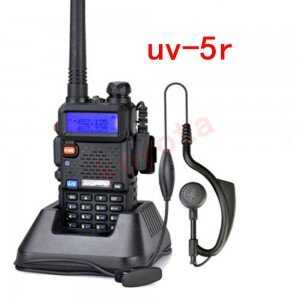
This is the most misleading story in the prepper community when it comes to radios. Unless you plan to learn satellite communications, they won’t reach more than several miles after the repeaters go down.
As I’ve explained in my previous two articles on radios, when you see a Baofeng or Wouxon “Ham” radio for under $50, that isn’t going to help you much in a survival situation. Don’t get me wrong. They are great radios, and person to person, I don’t think you can beat them for usefulness, but if you want to find out what is going on in the world around you, those radios are useless. The Baofeng UV-5R, (currently just over $30 on Ebay) is probably the most recommended on most of the survival boards. It covers 136 mhz to 174 mhz, known as the “2 meter” Ham band as well as 400-520 mhz, which is the block that covers most commercial handhelds. Those frequencies are called VHF, or “Very High Frequency,” and they are limited in distance to “line of sight.”
On the ground, person to person, the curvature of the earth prevents those radios from reaching out to each other further than about 7 miles for a 6 foot person holding the radio to his mouth. In practical experience, they never go more than a mile or so, because of the stuff in between the radios. Police, fire, and even cab companies use a system of “repeaters” to stretch the usable distance of VHF radios, and the Baofeng is made to use those repeaters. It will broadcast on one frequency and listen on another. Officially you need a license to do this, but the radios are shipped with the channels open. Ham radio clubs almost all maintain a local repeater for you to use once you are licensed, and it will reach out to about 40 miles from the base station when the base station has power.
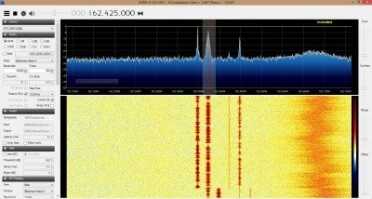
This is a screencap of SDR#. The top display gives you the frequencies, and the bottom is called a waterfall, which I find useless so far. These are the four NOAA weather channel frequencies within reach of my included steel whip antenna.
The problem is, if you look at the base of the large antenna towers in your area, you will see a propane tank on most of them. Some repeaters are solar powered, so post-collapse, there is a decent chance that they will work, but the ones with the propane generator probably aren’t going to function after a couple months. The Ham club repeaters are mostly just on grid power. That is why the Baofeng radios are so cheap.
Radio waves under 30 megahertz (30,000,000 hertz), also travel in line of sight, but they have a funny property that was discovered decades ago that makes them capable of traveling all around the earth. At certain times of day (usually at night actually), those waves, called “High Frequency” or HF, will bounce of the ionosphere and keep bouncing. Real Ham radios that cover those HF long distance bands are in general crazy expensive, from the high hundreds to mid thousands. And the rub is that when you buy them, they only cover the amateur radio Ham bands.

This is the book that is extremely up to date with the technology. The Kindle version is actually updated regularly. You won’t learn everything online. Buy the book.
This is going to be the first of what I hope will be several articles on a fairly new technology called “Software Defined Radio,” and it really changes the game when it comes to worldwide communications on the cheap. I’m just digging in myself, so I’ll cover the stuff I have learned so far, so we can go learn it together. The radio itself can be had for less than ten bucks, but it only receives. I do plan to get into the transmit radios down the road and I have ordered a couple, but there are much more serious cost vs. benefit considerations when it comes to buying what the Hams call a “QRP” radio, which is a low wattage radio meant to reach out to the other side of the planet.
The Basic RTL-SDR Radio
The physical components in a traditional radio are not the only things that make it expensive. The circuit has to do a lot of things, and the research that goes into those things is substantial. Receiving a signal starts with the antenna, which receives the wave of the signal, and passes it to a crystal or chip that de-oscillates it into a tiny little sound. That tiny little sound then has to be amplified, usually by a transistor network, and the slightly bigger signal is then processed into filters and other amplifiers, for what eventually comes out of your speaker. Add some control circuits, displays, digital display driver boards, and the firmware to make them work, and it adds up to a pretty big engineering project. Simple, single channel radios, especially QRP radios (usually around 7 mhz), can be had for cheap, but until now any kind of multi-band receiver has been expensive.
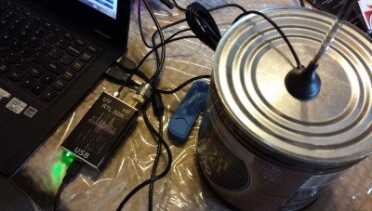
This is a tip from the book I didn’t see online. Use a metal “ground plane” like this coffee can, to improve the reception of whip antennas. It works great.
Then someone in China decided that the consumer market needed a USB dongle that could receive TV stations, and they knew it had to be cheap. The resulting product is ten to twenty bucks and it is still being sold worldwide as a TV receiver only. Enter the geek brigade, who quickly figured out that this new chip could be used to receive a very wide band of frequencies, and because it was already digitizing and tuning the signal, a simple software program could control your listening enjoyment.
I am not going to get into the whole story or explain the chip structure because from a survival perspective, GO AND DO IT is all that matters. Their are now hundreds of websites that have information on the SDR radios, and the best book is available on Amazon for $18, free on Kindleunlimited The kindle version is updated all the time with new information, but even the printed version is very up to date. I am writing this at the end of August 2015, and the print date of my book is August 12th 2015. They are using just in time printing, so don’t hesitate to order the book.
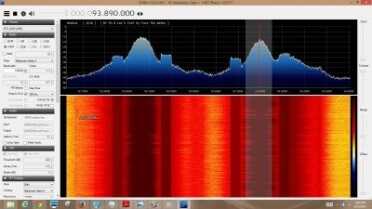
You will see your local radio stations in the 88-108mhz range. They broadcast in “wide FM” which takes big chunks of frequencies. If you make this picture bigger you will see that the radio even shows you the song names on the digital stations.
The website from the author, Mr. Carl Laufer, is https://www.rtl-sdr.com/. I wouldn’t say it is the only definitive guide, but it will get you started, and it links to all of the resources you need. They also sell a slightly more expensive dongle that includes some signal filter upgrades and a more temperature stable tuning chip. The cheap dongles drift a bit, which can be a pain if you are using a frequency storing program to check different channels.
When you get your dongle, DO NOT install the software that comes with it. You can also throw away the remote control, unless you want to use it to watch TV. Download the Zadig driver software, and follow the instructions, manually running it as administrator. I’ve included some screen caps here so you know what you are doing a bit, but there is much better information out there if you need some hand holding. My dongle did now show up as “Bulk In” like you will see on the Zadig instruction pages, but after some installing, removing, and reinstalling a few times, eventually it worked. If I can give you one tip, it is that if SDR# gives you trouble, close it, plug in the dongle, and re-open it.
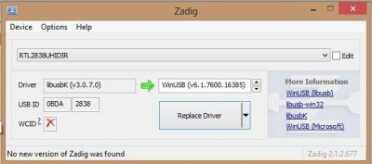
Do not install the CD that comes with your dongle. Just plug it in and use Zadig to install the drivers. Run Zadig as administrator.
SDR#, pronounced SDR Sharp, is the leading free program to process SDR signals. It seems to be very processor intensive, so if you have an old or slow computer, you may want to try HDSDR. You will need to install Zadig and run it as administrator before you can use them.
I can’t speak to how different one dongle is from the next. As I’ll explain, I bought the more expensive dongles as well as the cheap ones, and that little blue one seems to be the most sensitive. There are now a couple versions of both the receiver and tuner chips, and one tuner chip is not even made anymore and has gotten very expensive to buy. If you want the latest chip and the temperature controlled tuner, and you want only a basic dongle, buy the RTL-SDR.com dongle.
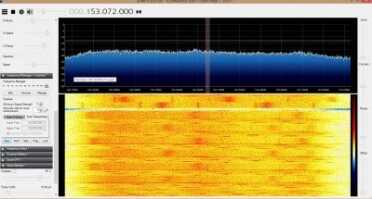
If you look to the left you’ll see the scanner plugin for SDR#. There are a few of them. This is the one that has the frequency manager built in. I was scanning local police bands here and got some hits.
Adding a Police, Fire, Military Scanner
SDR# is the most supported software partially because several people have written plugin programs for specific tasks. You can track satellites and download weather maps. You can decode digital voice signals, and the most important plugin I would say is the scanner and frequency manager plugin. You can’t watch more than a couple megahertz wide of frequency at one time, so using your computer to scan in frequency ranges, or scan a list of known frequencies, is a real gift.
To find your local municipality frequencies, you can use the online RadioReference.com. It is something of a Wiki, so it gets updated by the admins on a regular basis. Before the internet goes dark it would probably be a good idea to run all the frequencies for your local area and print them to actual paper, as well as save the pages to your computer.
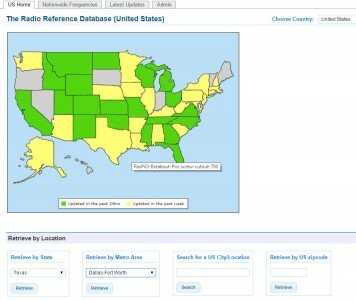
To find your local police, fire, and even media frequencies, go to the Radio Reference site to the left here. Download and print your list so that you can monitor it without the aide of the internet. Just beware that you will probably need some the trunking plugin and you’ll have to learn how to use it.
What you will find if you try to go listen to existing traffic is that most public agencies have moved to some kind of digital “trunking” system. A trunking system controls a block of several frequencies, and splits up all communication over them as needed. That way everyone doesn’t need their own frequency, because not everyone needs to talk at once. They also tone code the radios, so even though the antennas on the police, fire etc., cars all pick up the same signals, on their relevant messages will come through the speaker of the radio. It’s pretty nifty stuff, but if you want to master it, you have to dig in and spend some time with the terminology and the technology itself. People are out there listening today, and all they did was figure out what other people explained.
All of the SDR# plugins can be found on one page at RTL-SDR.com, and
SDR Radio Antennas
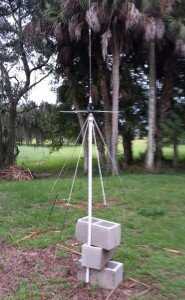
This is the Discone antenna that I bought for about $50 on Ebay. Even at this height, just mounted on a 5′ piece of PVC, it showed a notable difference in all of the VHF and UHF frequencies above both the included whip and my “multi-band” wire antennas. Up high, using a mast system, it’s going to rock.
Your dongle SDR will come with an antenna, usually connected with a tiny little connector. If you are at elevation, that little antenna outdoors will pick up a surprising amount of stuff, but you are much better to invest in an outdoor antenna and get it up as high as you practically can. The people at RTL-SDR.com suggest using a “Discone” antenna, and as you see from the pictures, I got one. It is head and shoulders above the tiny whip that comes with the dongle, and as multi-band VHF/UHF antenna, you probably can’t beat it. I went from unable to hear local police communications with the included antenna indoors, to able to hear everything, even the local airport, with the Discone only a few feet above the ground. For how much antenna you get, the $40-$60 standard Discone antennas are pretty good.
From a survival perspective, getting that antenna up in the air can be a risky proposition. A visible antenna probably isn’t as bad as visible solar panel to the risk of passing aircraft spotters, but it isn’t great either. I’m not going to bother covering those giant Yagi style Ham antennas, but if you want to go down that road, go for it. What I can share is that there are a ton of surplus 4 foot mast sections on Ebay, and they are much cheaper than a similar length telescoping mast. The telescoping masts are nice, but I don’t have a lot of faith in the ability of galvanized steel to retain the ability to telescope when left in the elements. As long as you have guy lines for the aluminum military poles, they will hold an antenna just as good. And it only takes one person to put them up, and you can get a tripod base for them on Ebay as well.
Also note that the Discone antennas claim to handle frequencies from 25mhz up to gigahertz, and that includes the 10 meter, or 30mhz Ham band. I didn’t get anything, using my Up Converter, which means you need an actual HF antenna if you want to work on the Ham bands. Oh yea, what’s an Up Converter?

From what I can tel, Ham it Up, from NooElec, was the original “Up Converter.” The job of the device is to bump the received frequencies up to a level that the tuner chip can handle.
Adding the HF Range
Haha! You thought that you were going to get away with ten bucks. Nope. But for ten bucks you can see if investing more is worth it, and in the meantime you’ll have a radio that will see and show you every frequency between 100mhz and 1.7ghz, if you can get the antenna up high enough. The dongle is pretty cool as it is, but if you want the frequencies below 100mhz, you need what is called an “Up Converter.” The receiver chip in the dongle gets all frequencies, but the tuner chip can’t handle anything below 100mhz. An Up Converter is a little device that takes the radio signal and converts it to the higher frequency that the dongle tuner chip can deal with.
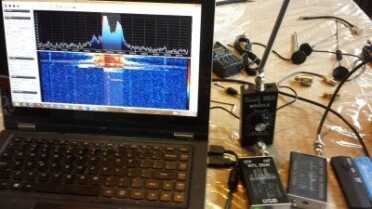
The two rectangular box SDRs you see here in the pics have an Up Converter built in. Testing them with my real Ham radios, they do receive the correct frequencies.
The original concept seems to have been produced by a company called NooElec. They are now up to the 3rd version, because customers suggested improvements. I bought Ham it UP V 1.3 on Ebay, but then I realized that you don’t save anything from not buying it on their website. They have other add ons for the Up Converter as well, and I ordered them for a followup article.
But what I also found is that there are electronics suppliers in China who have copied that rather simple circuit and integrated them into standalone 100khz – 1.7ghz RTL-SDR radios. There are now lots of sellers selling several versions, all around the $50-$70 range, and in DIY kit form for as little as $30.
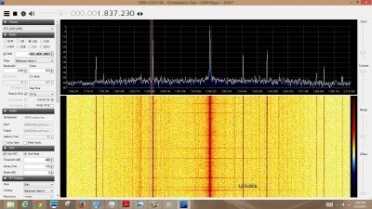
The Ham it Up converter requires that you set a -125,000 in your SDR# settings. These combo units don’t seem to need that, but I’m just figuring them out. These are beacons that I picked up with the small Miracle antenna.
The two combo units I purchased are linked at the top of this article and there are several pictures here. I am still trying to figure out the difference between the two, if there is any. As you can see in the pictures, one has a switch to go between HF and VHF/UHF, and the other doesn’t. I assume the switch is just an antenna selector, and the one without the switch simply connects both antennas to the circuit without a switch, because someone apparently figured out that it was superfluous. These radios also come in an aluminum box, which is something you have to buy separate on NooElec for the regular dongle SDRs. If you plan to just get one of these and start rolling, I would suggest the one without the switch, and don’t bother with the $10 dongle. My connection wires have not come yet to try the Ham It Up converter with the dongles, but there will be more of these articles coming. Again, I’d like to just get this out there for my regular readers who may not have heard about it, and we’ll learn it together.
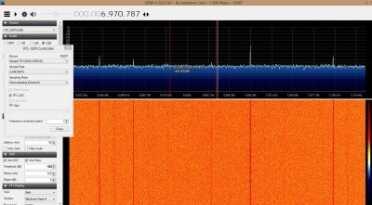
It seems with these combos that you just set the sampling to Direct (Q) instead of Quadrature, and it automatically transposes the chip.
Antennas for HF
I picked the wrong do to stop sniffing glue when I delved into HF Ham antennas for my prior articles on survival radio. These days I have no less than a dozen of them, and I have yet to try all but two. My personal time, like yours perhaps, is divided among way too many things to spend a lot of quality time on one, but hey, if the SHTF, I’ll have a lot of stuff to try to figure out, and no internet to help me, which is why I buy printed books, which I’ll get to.
For my Ham backpack radio article I showed you some great antenna options for not a lot of money, but I recently figured out an even cheaper one. It is…drum roll please…, a piece of wire.
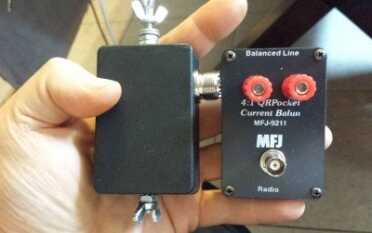
In addition to the antennas that I covered in prior articles, all of which have great reviews online, I have recently discovered the “end fed dipole,” otherwise known as “random wire” antenna. You use a “Balun” (some say Unun), which connects to your radio with standard coax, and a piece of wire strung to a tree or something. They are cheap cheap, and they work great for HF frequencies from what I have read.
Radio waves and antennas are interesting animals. After a ton of reading, both online and from college level radio engineer books, I can assuredly say at this point that radio and antenna science may be old, but it is still evolving and probably quite young in terms of what they will eventually figure out. I have found that one little detail can make a difference between making contacts and not making contacts.
The key to the piece of wire is a little device called a “Balun” or some people call a similar device an “Unun,” Balun being much more prominent. That a Balun seems to do is bring the impedance of your single strand of wire antenna down to where your antenna tuner can dial it in. As long as the antenna is a correct length, usually longer than 1/4 of the wavelength, it is not uncommon to both hear and speak to to contacts from all over the world at favorable times in the atmosphere.
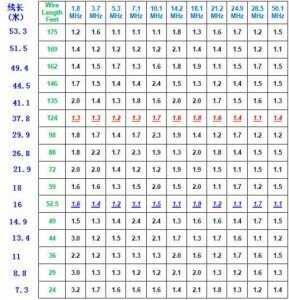
These are the approximate wire lengths suggested for use with the small ten dollar Balun I found on Ebay. The left column is the band, in megahertz. The next is the wire length, and the subsequent columns are the estimated SWR at the different frequencies. It assumes you aren’t going to use different lengths of wire, so it gives you the optimal length for that band, and shows you the SWR at the other frequencies that you might use. They are all respectable. Anything under 1:5 SWR is usable.
I found two really well reviewed Balun/Unun products on Ebay. The one based in the US is $37.99 shipped, and he has a video on the ad page that is pretty good. There are several sellers in China selling the same type of product, a 9:1 Balun, for just over $10. I have both on order and hope to do a real test with them soon with both the SDR and traditional low wattage radio.
I tried two antennas with my SDR on HF frequencies, and they do work, because I have Ham radios that can transmit and I tested them with HF signals. The problem is I didn’t get any signals from anywhere but a few feet away. Both antennas are what I would call gimmicky though. One is called the “Miracle Antenna” and it is no longer made. I looked around online, and it is little more than a Balun and antenna tuner built into one package, so with the stick antenna it wasn’t going to do much more than it did indoors. The other one is from https://www.mfjenterprises.com/. It is their 1621 mobile antenna that uses a regular stick and floats over the bands with an internal wandering lead to extend the length of the signal. What kills me is that I know with a little time and patience, and a little more research into cleaning up the SDR signal, the 1621 will work great. So please don’t take my extremely limited testing as a condemnation. I have about 6 different types of antennas from MFJ, and their SWR meter, so you’ll be seeing more of their stuff as I have time to work on these very involved articles on radio.
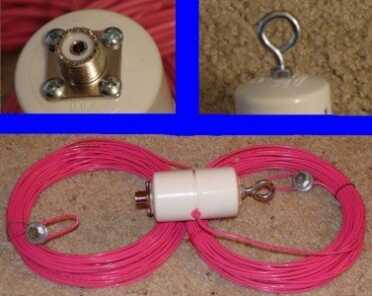
This guy is selling Dipole antennas on Ebay for little more than cost. Dipoles are much less tolerant of length differences, but you can use standard wires to make antennas that are tuned to other bands. This is his 40 meter, which is the frequency of many of the QRP Ham kits for cheap.
Dipole antennas are the other very low cost option, and they likewise can be made yourself, or purchased cheap from any number of suppliers. There is a guy from California on Ebay offering the different Ham bands in Dipoles for little more than the cost of the components. You can also just buy the middle and side insulators if you look around, then make your own wire connectors for the various bands. Each band requires a different length wire to meet the frequency resonance within the range of the antenna tuner. There are also a lot of wire-type multi-band antennas, some of which I have purchased and that were mentioned in my prior articles. At some point soon I’m going to get to them.
I discussed the most affordable automatic antenna tuners in my radio backpack article, so I am not going to return to that subject for now. Manual tuners are few, but there are kits right now on Ebay for under $20 that you need to solder. I’m going to try one.
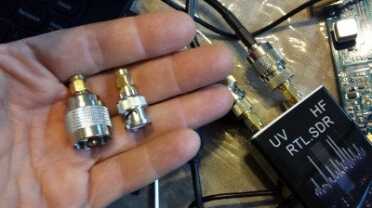
If you want to play with all this stuff, make sure you get male and female adapters for the different types of plugs.
Just be aware that when you are connecting radios to antennas to Up Converters to tuners etc., there are several different types of plug ends and you may need adapters. The little screw plugs on the Up Convertered SDRs and the Ham It Up are called SMA. Many of the low wattage antenna connectors are BNC connectors male and femail, and the larger coax plug has two names, the SO-239 and PL-259 for female and male respectively. The dongles come with several different types of connectors. The small one is called MCX, and the RTL-SDR.com website sells packages of adapters for both the MCX and SMA that are very reasonable.
Reading Up and Backing Up
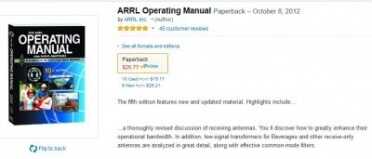
If you want to learn how to use the dongles for Ham radio things, even talking to satellites, you have to understand the underlying concepts. I strongly suggest this 2012 ARRL book, even though it doesn’t mention SDRs. It’ll give you all the beacon frequencies, busy frequencies, and help you understand “band plans” which are pretty rigid in the Ham community.
Obviously I would buy the RTL-SDR book, but there are more books that you should get, because the internet is going to go dark at some point. However, let me premise that by saying that you also should download every piece of software for your radios you can find and put them on a thumb drive so that you can use them on any computer you may find. At some point I am going to do a “survival computing” article. One of the commenters on a prior article here turned me on to a “buck converter” you can get on Ebay that converts 12vdc to the 19vdc that your laptop needs, which is cool because you don’t need an inverter or an adapter to run your laptop from a regular solar storage or car battery.
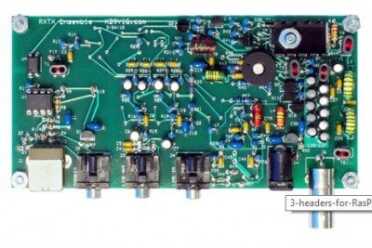
I hope to be back with a review of a couple of the transmit capable SDRs, including this $89 SoftRock available at FiveDash.com. I bought 4 of these that cover all the Ham bands, and they look a lot more flexible than a much more expensive QRP radio like the Yaesu FT-817. Who knows?
If you didn’t already buy the Ham Radio for Dummies book, you may want to get that. If you wan to cut right through it all, the ARRL Ham Operating Manual is extremely specific in everything from what frequencies you can monitor to test your rig to the lengths of wire to use for the different bands on a Dipole. They have great information on communicating over packet protocols through a computer using a traditional Ham rig, but I didn’t find anything in that book on RTL-SDR, since it was invented about the same time as the book was published. There are plenty of books out their to help you get your Ham license, but as I warned in my prior articles, if you are under 50 years old and could potentially be drafted, I would not rush to get a Ham license for pure survival. They are going to start a war to cover up the mess, and nobody of fighting age will be exempt. You can listen with no license. If you can hear them, and you have transmit power at all, there is a good chance that in the same atmospheric window they will be able to hear you. These SDR radios don’t transmit, but I’ll be getting to some that do, as well as some other low wattage cheap worldwide transmitters.
So Much to Learn, So Little Time
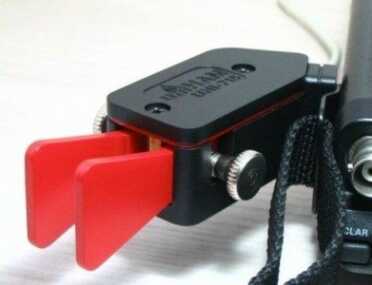
Don’t discount low wattage QRP radios to contact family over thousands of miles. If you are willing to learn some Morse code, it doesn’t take a lot of wattage to make contacts if you have a good antenna.
I sincerely hope that we make it through this fall without this whole mess coming uncapped. But I don’t think we will. I can only get one of these articles out per week, and I have to divert to some more food topics, a good trauma pack, and a couple of nifty thermal power inverter products that will charge your phone while you cook dinner fr now. So while I will continue to try to make time to learn my radios, I won’t be back in this column with them for a while. If you want to dig deeper into SDR radios and other cheap alternatives, these are some of the things (besides the antennas) I am working on.
- Try the Ham it Up converter with its accessories from Nooelec. – They have their own 9:1 Balun product, and some noise filter accessories for their SDR.
- SDRs that transmit. – Low wattage radios are called QRP radios, and there are several SDRs out there that range from $89 to $300. I’m going to try a couple, but unless I am willing to get a Ham license, I have to find someone to transmit for me. What I like about the SDR QRP radios is that they cover a whole band of frequencies and not just a thin line of the actual Ham band.
- QRP DIY traditional radios on 40 meters. – If you search Ebay for QRP radio, you’ll see a number of electronics kit options from $10 to like $50. They range from a fraction of a watt to about 8 watts, which is plenty of power to reach out to Japan on a favorable night. These kits all transmit and receive n the 40 meter, 7mhz Ham band only, so they are extremely limited, but with a small Balun and a wire, you could theoretically establish a good communication with faraway family, if you do it now.
- Morse Code – Oy right? Well no actually. Morse code is not just an old and antiquated language. It is still used today in the Ham community, because it allows you to focus a small amount of power into a very thin band of frequency, which gives you literally worldwide reach. There are now Morse code readers, and even a keyboard typing translator from MFJ. If you live in New Hampshire and you have family in Montana, it would behoove you to get a couple of those 8 watt kits and a paddle, as well as the more advanced options.
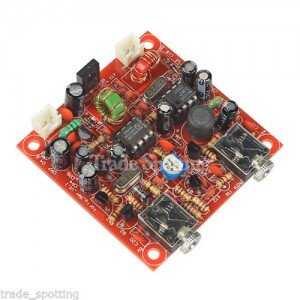
Don’t wait for the next article if you are trying to establish communication with distant family. These DIY 49er QRP kits are under $20. They will allow you to send Morse code over the 7.023 frequencies. BUT BUY FOOD FIRST!
Just like the stupidity of buying a few ounces of silver to “preserve” some of your cash, I don’t suggest that you invest in anything more than the $10 dongle if you don’t have a good supply of survival food. A 50 lb. bag of beans has 50,000 calories and is about $40. A 25 lb. bag of sugar is about $15. With a reliable supply of fresh water that’ll keep you alive for a couple months while the useless masses of sheep fight each other for the few crumbs they had in their pantries. Keep your head down, your lights off and your doors locked, and live. Down the road it wouldn’t hurt to have some electricity and communications, but that isn’t as important as food. This radio stuff is really cool, and it’s great brain food if you are an information junky like me. But things are getting nasty now and I don’t think it will be long.

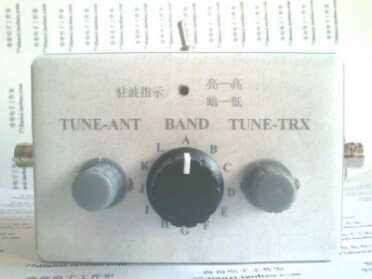
Any tips for listening to traditional ham radio with the sdr?
I bought an rtl-sdr with the ham it up (1.3), with a 5ft antenna from amazon. All I hear is static though on SDR#.. I’m tuning to 152.4mhz (125mhz + 27.4mhz), What should the other settings be (AM, SSB UB, SSB LB, etc)?
Thanks!
awesome post!
I’m looking for a way (splitter) to ‘peel’ off the AM, FM & TV frequencies and send them to their respective receivers. I’m using a 25mhz-1.2ghz multi-band discone antenna with 50ohm impedance. AM should be 300ohm imp. while FM & TV should have 75ohm imp. This is a receive only setup for multi-frequency monitoring. Any help would be greatly appreciated. Thanks, KH
OK – once again I humbly request someone make a simple list (for us simpletons, non-geek types) of one good set of hand-held radios for short range communications needs (i.e. “Walking Talkie”) and a recommendation or two for a reasonably priced receiver radio to pick up world wide news broadcasts. After focusing on food storage, solar/wind power options, batteries, home and self defense, security preparations, emergency medical skills and medicines, hand loading of ammo, fuel storage, et al, I am running out of time before the SHTF! So please – a short list of recommended brands/model numbers for my communications shopping list.
I am humbly asking for a little help. I live in a coastal community in Oregon and reception is poor and I live in a metal (grounded) building. I bought a pair of omni-directional antennas and a Skywalker SKY38323 uhf/vhf/fm 25 db distribution amplifier(Variable). Dare I use one antenna for the outside and the other in the attic for coverage inside or is there an inexpensive project I cam make? By the way, all units are 75 ohm.
Your advise will be greatly appreciated.
Gary.
Thank you sir for your prepping articles, I am also a Ham operator, W5CEH is my call . I enjoy reading all your articles, and I really like the one’s on SDR. I am currently trying out several of them my self for when the SHTF. Thank you very much for all your work. Charlie Harris
The controversy with regards to Licensing be it for firearms, radio communications..whatever.
Here’s is my perspective.
Get the License.. .. here is why.
There is something called the Law of Exigent Circumstances… which means if you are in a crisis situation you may do that which is necessary to preserve and protect innocent life. So in a crisis you would carry license or not.. you would transmit license or not.
For example.. your a farmer and a fire starts by your fields (or in them) you need your neighbors tractor to help fight the fire but your neighbor is not home.. You may take it and use it following the law of exigent circumstances of course it would be expected you would fight just as hard to protect your neighbors field as your own.. however that is just part of the totality of your defense should you be challenged for taking his tractor. So in the unlikely event you would be challenged as to your actions you would have a legal defense.
More humorously if you look up the term there is an effort receintly to suggest the term only applies to law enforcement…they are confused.
Being on a list.. sure it is wrong it is a rip off.. But it goes a long way to avoid problems carrying a firearm or using a radio (Transmitting) during non crisis time.
Easy Peasy
HAM??? I am lucky to use SIRIUS XM RADIO effectively in my F150 pick up truck. I know NOTHING about what is written here, .. like a dog watching TV .. I know something is happening, but not sure what it is. Stone me if you will, but I was hoping I could ‘buy something’ that would allow me to listen to broadcasts from close to far away. I think it is here and it is affordable, but I don’t think I will EVER have anything that will do it. WAAAAAAY too technical for me. Hope someday there will be an article that can lead me to it. Probably not though.
Just take it slow. None of us know what any of this means at first. That book helped me get things installed, and when you just follow the steps you’ll be surprised at how it makes sense when it you see it do the things in the book, and the things I have explained.
I am a licensed amateur radio operator callsign K8IDX. I hold an Amateur Extra class license which is the highest license class and the most difficult to obtain. I have been a ham since 1974. I was very happy to see this article and most of it is correct, but not all. One mistake is that QRP (low power usually under five watts) transceivers require CW or code to make successful contacts. There are many long range QRP contacts made all over the world every day using SSB (single side band) which is a voice mode. I have worked Cornwall England with only three watts from my back yard in Alabama using SSB voice. I should add that while voice modes work very well in poor conditions it is possible to get a CW signal through when most other modes fail. If you like computers there are digital modes that compare favorably to CW in their ability to get a weak signal through long distances and poor conditions.
Another point I would like to make is that you don’t have to spend large sums of money to get the equipment needed to operate on the HF and higher frequency bands. There are excellent transceivers that can be purchased for just a few hundred dollars used. While it is a fact that most ham gear has a very high resale value compared to other electronics, I would in fact recommend older radios because they do not have tiny surface mount parts and can be repaired without the expensive rework station required for repair of surface mount (newer) equipment. Although the performance of some of the newer gear is nothing less than spectacular. I have to add that performance is generally only needed for “contesting” which is trying to make as many contacts as possible in a given period of time competing against other hams to win certificates. I have never participated in a contest because I just don’t feel the need to compete against other hams. Contesting is something that some hams love and others like me find no need for. The point here is that you don’t have to spend 10,000 dollars for a radio to operate successfully over long distances. Five hundred dollars or less will get you a very capable transceiver.
Another mistake is that ham radio gear will only operates on ham bands. Most amateur radio transceivers require only a simple modification to allow them to operate off of the frequencies allotted by the FCC (Federal Communications Commission) to licensed amateurs. Almost all ham gear come with general coverage receivers straight out of the box. It is only the transmitter that requires that simple modification for general coverage operation. Ham radios are designed this way allowing them to be modified for general coverage operation because new ham bands are sometimes allocated by the FCC, and there are special bands used by military organizations such as Army MARS (Military Amateur Radio Service) that many hams participate in.
There are several other points I could make here but I don’t want to write a book in this comment. If you are interested in radio or would like to get your amateur radio license feel free to contact me via email at my callsign which is k8idx, with the domain mchsi.com. My name is Paul.
My call sign is W8SRN and hold a General license. If one wants ham equipment at a good price, go to a ham fair where people are selling equipment that they no longer want. I’ve seen older tube HF equipment that needed some minor repairs or just new tubes go for less than $200 and older, functional VHF mobile radios go for $50. With a tube HF radio, you’re EMP proof unlike a semiconductor laden laptop. If terrorists, God forbid, blow off a nuke, you’re still on the air with a few car batteries.
Regarding VHF/UHF being short ranged, it is a function of power and bad antennas. When a ham buys a hand-held radio (“HT”), one of the first things that he/she does is replace the “dummy load” antenna that came with the HT with a more efficient one that allows the radio to utilize its full potential of 5 watts (2 meters VHF) and/or 4 watts (70cm UHF). My brother and I use our HT’s while hunting in hilly, heavy woods and talk to each other from up to 8 miles away without using a repeater (known as “simplex”). While using a mobile radio with an output of 50 watts with a 39 inch, high gain antenna, I talked to a Ham in Cleveland on 2 meters while driving in the far suburbs of Detroit (the conditions were perfect that day for simplex). My modern HF/VHF rig runs 100 watts on the VHF bands of 6 and 2 meters in either FM or upper side band. With a tech license, a high gain antenna, and perfect conditions, I talked with Hams in Alaska, Hawaii, Belgium, Ireland, Germany, and other countries on 6 meter sideband. With 100 watts on 2 meters, again with a high gain antenna, I could bring up repeaters in Detroit, Toledo, and Canada when I lived in the Lansing, Michigan area.
So with a little study, the purchase of a used, 50-watt mobile rig, and a high gain antenna, which you can either make or buy, that is put up as high as possible, you can have tons of fun using local repeaters, linked repeater systems like we have in West Michigan, or simplex with a friend across town. Upgrade to general (no morse code required), a used HF radio and a homemade antenna will open up the world. 73 de W8SRN (Scott)
I have an article coming up on the Yaesu FT-101 and Kenwood TS-520. There are a lot of great buys on HF rigs out there for $300 or so.
Don’t let the trolls get to you. Your article is filled with a lot of information. Our group member all have ham radios and listen in a lot to the local and not so local ham stations.
I look forward to your next articles about the little Dongle boxes.
BTW… I don’t have a ham license. WROL operators won’t need one.
Not to bad an article, don’t let the naysayers get you down, What was funny was had just discussed the SDRs the day before you posted your article, on a couple groups, and have been working with them since. I rate them as a must have tool (and especially more so than just having them, but to master their use) for the survivalist, likely right up there with good night vision.
One correction, the device on the far left is a direct sampling device, though it does have some filtering and such to go with it, but it does require some very skilled soldering if built from the kit. Have ordered one of the ones next to it to see how it works, and should be here the next couple day. It might be on par with the DX patrol, and it is a build with an upconverter.
As far as CW goes, there are rigs for about the same money (a little cheaper if you look for them on the order from china sites) that are computer controlled for the code output (they have a serial port built in) and there are programs that will decode the incoming code. They can be bought both assembled and in kit form, but the crystals have to be changed like most the units coming out of china to the band we use here.
There is also software to decode CW and for the SDRs that work with android, which is rather sweet for energy savings. Good hunting, Goat.
It isnt a direct sampling device. It is what it says it is and has been used a lot. I am actually reviewing a couple of CW options, but haven’t done the android version yet. That probably is the cheapest way to deal with CW. Those Chinese kits all work on 7.023. Radio to radio it’s fine for contacting loved ones who you have set up with the same radio. I have yet to build mine.
Don’t get touchy, but as a QRP CW operator myself I can tell you QRP is an expert mode and not to be relied on for critical communication. I use kit built transcievers running 2 – 5 watts and have made many amazing contacts. But that small signal really relies on the band being open just right to get through. Also you must have excellent operating skills and obviously be good at sending and receiving CW (Morse code). And of course a huge, very high, full size antenna really helps too. Thinking you will be able to have reliable commo with just a QRP rig is a bit of a stretch. If you take exception to this I’ll be glad to compare log books with you.
Yes, top picture, the sdr on the left is a direct sampling device. The one next to it with the toggle switch actually has an up converter built in it, that is switched in by the toggle switch. I actually have the one with the up converter and it is a very nice device, and the other one that is direct conversion can be bought for about $20 or so in kit form. There isn’t a whole lot of information on how to build it, but there it least one site that has a pretty good go at it, and it shows it to be a dongle which has had the direct sampling mod done (just as any of the dongles can), with some added filtering and a nice case. There is no mixer which would be required for there to be an upconverter.
I’ve spent many weeks researching the different sdrs, before and after you wrote this article as I said elsewhere, so not just blowing smoke, please do feel free though to correct my error if I’m wrong with some proof it isn’t, I place a premium on having correct info (which is sometimes hard to ascertain on the net these days).
I’ve also “played” with the dongles, which can be useful, but not ideal, the soft66 with upconverter, which is a good as the one pictured above with the upconverter built in, but has different characteristic in that it also has a pre amp built in (and is a little cheaper, but maybe slightly more prone to noise), as well two of the hackrfs. Of all, the hackrfs are at the top of the pile, and while a bit more pricey, not only have more coverage, but as well transmit, though they are half duplex (why two is nice to have). The hackrfs can be ordered off some of the Chinese sites, with all the upgrades, and a very nice case too, for about $330 per shipped.
Here is the description from one of the auctions off ebay for the direct sampling kits off ebay.
http://www.ebay.com/itm/131571773593?_trksid=p2055119.m1438.l2649&ssPageName=STRK%3AMEBIDX%3AIT
“The receiver take RTL2832U + R820T programs , *taking advantage of the Q channel RTL2832U on adding support for frequencies of 100KHz-24MHz* , realized the reception 100KHz-1.7GHz .”
Pertinent part being between the *s.
RTL-SDR Direct Sampling Mode
http://www.rtl-sdr.com/rtl-sdr-direct-sampling-mode/
‘Activating direct sampling mode requires a software driver adjustment. Luckily, SDRSharp has this adjustment as a built in option. In SDRSharp, go to the configure menu, and change the sampling mode to “Direct sampling (I branch)”, or “Direct sampling (Q branch)”. The I branch corresponds to pin one/pin two, and the Q branch corresponds to pin four/pin five.’
Last one, I promise.
Here is a listing off ebay for the exact one shown on the left.
http://www.ebay.com/itm/USB-Full-Band-Tuner-Receiver-100-KHz-1-7GHz-UV-HF-RTL-SDR-R820T-8232-Ham-Radio-/281855221272?hash=item419fe15e18:g:K~sAAOSwLzdWRDpq
“This is RTL2832 idle Q channel, connecting the broadband impedance isolation transformer provides the HF signal to the HF band signal reception, and increase input low-pass filter to improve anti-jamming performance of the machine.”
BTW, just the dongles work pretty well for receiving shortwave with just the modified drivers, and no mods at all. The main problem is the noise levels across the scale with the unmodified dongles (though they can as well be modified with filters and such if one works at it, and you really need a proper antenna for any of them), which this device above tries to address somewhat with some filtering. For the extra little bit of money, off ebay, the one to right with the upconverter built in is ever so quiet as far as noise, and very much more sensitive to signal, that it is worth spending the little more on it, which can be had shipped from the US also for no more so then the ones shipped from Asia.
http://www.ebay.com/itm/100Khz-1-7GHz-Full-Band-UV-HF-RTL-SDR-Upconverter-USB-Tuner-Receiver-2832U-R820T-/191564644649?hash=item2c9a248129:g:WWEAAOSwrklVOJGv
Soft66RTL2
http://www.ebay.com/itm/NEW-PRICE-Soft66RTL2-HF-VHF-SDR-0-5-to-1-7GHz-RTL2832u-R820T-with-upconverter-/200995782768?hash=item2ecc484070:g:grAAAOSw-W5UwhlW
Not only can the hackrfs be ordered out of Asia for a good price, but the same guy that sells them also sells the ham it up upconverter for a very good price, with the upgrades completed (noise source) on them as well. If one doesn’t mind the expense, the hackrf really is a very nice and ever so much more useful device of them all. It will do DC to 6 gig and no fooling around with upconverters and such.
Hackrf
http://www.aliexpress.com/item/HackRF-One-Software-Defined-Radio-RTL-SDR-10-MHz-to-6-GHz-Great-Scott-Gadgets/32368005677.html
Hamitup upconverter
http://www.aliexpress.com/item/Ham-It-Up-v1-2-RF-Upconverter-For-SDR-Funcube-RTLSDR-MF-HF-Converter-R820T/1553952434.html
“UV-5R isn’t going to help you much in a survival situation”. The UV-5R radio is perfect for camp or neighbourhood security when the cops won’t show up. It also has FM radio for emergency broadcasts and a built in flashlight. I think your problem is that you tend to draw quick conclusions regarding these topics without much thought..
My gosh this is a rambling poorly flowing article with good info but woefully insufficient of details and the WHY’s/HOW’s.
Your ignorance is astounding stating VHF/UHF “in practical experience, they never go more than a mile or so, because of the stuff in between the radios.” You obviously have never RDF’ed a 2m/440 signal. If you need to listen to PD/SO & NOAA these cheap eBay VHF/UHF radios are perfect! Govt E-Info will be on NOAA.
QRP-SSB (=<10W TX) operations requires a big antennas (long-wire/full-dipole) to be effective. QRP-CW is the most effective BUT it uses Morse Code (no longer required for any HAM license). Will the average Prepp'er learn Morse Code just to listen to HAM info, don't think so? Hell, CB/No-coders cried foul until they got Code tossed. The bottom line is Morse Code is the most reliable and gets the message through, even the movie 'Independence Day' demonstrated that.
Then there is the other BIG issue ALL radios requires electricity in some fashion, less for RX and much more for TX. PLUS all SDR's require a computer/monitor or Notebook/Tablet/etc. Again renewable power becomes an issue battery, solar, wind, chemical, bicycle, generator, etc. Very few how-to articles of human/bicycle or bike/wind/solar charging setups are shared. I'm using a 60A Solar controller to control/switch/trickle-charge my shack battery and AC power supply on my chack common-DC buss.
If the Govt shuts-down HAMdom [and cell/internet] (like during WWII), in this day and age we can count on Pirate Stations getting the 'real' uncontrolled word out. FCC RDF'ing is a joke, providing a Pirate station remains mobile/location-hopping – detection will only be by blind luck or someone finking them out.
You had the makings of a good article you just lost focus/cohesion and went rambling.
BTW… I just went on Ebay and was looking at these devices. One important thing to remember. Most of these adapters say they receive AM, FM and CW (continuous wave = Morse code) ONLY.
On the HF bands HAM operators use LSB (lower side-band) for the 7 MHz bands and below (40, 75/80, 160 meters) and USB (upper side-band) for every thing above 7 MHz (20, 15, 10 meters).
AM is not used at all by HAMs at all and FM is only used on VHF/UHF repeaters for local communications.
Point is, you won’t be able to listen to long range HAM traffic on HF (other than Morse code) with these devices. Shortwave stations do broadcast on AM, as do CBers, so you could listen to those.
This is absolutely untrue, and if you had bothered to read the article or look at the pictures instead of just spouting what you think you know you would have seen that the software has complete control over your bandwidth and type of signal. There are pictures of using USB/LSB, which are both AM, just half width. The pictures clearly show the selector for NFM, WFM, AM, USB, LSB, and other bandwidths only used for specialty signals. This is the problem with comments online. Nothing qualifies you to make them except for your own ego.
My ego and 25 years as an extra class HAM operator. Why you so touchy about this. You know perfectly well these things are neither optimal for SSB HAM use, or plug and play. Save your money, learn what you’re doing and set up a proper station.
Hi Steve. I don’t get it. You offered up some good info and then get spat in your face. What many don’t understand is that hams want to help others enjoy their radio(s) and go out of their way to offer up info to do just that. We also have some pecuniary interest, too, in that we want to see people using the frequencies the best way so that we can maximize the enjoyment for many — not just a few. It does pay to learn how to do it before you really need it for all involved. I enjoy reading the radio articles but I think Paul owes you an apology for his ungentlemanly response to you. Take care. I’ve been enjoying ham radio for 30+ years now but haven’t been licensed as an extra as long as you, Steve. I’ve only got 10 years or thereabouts as an extra. -73
No problem Ken and thanks. 73 de KS4HE
I occasionally see people who purchase HAM gear and then moth-ball it in their cache. The theory being, “I will hook it up and figure out how to work it after the SHTF”. That is like someone who never owned or fired a firearm doing the same thing. HAM radios are not just big CBs. The hardest thing for a CBer becoming a HAM is unlearning all the wrong stuff they learned as a CBer. Trust me on this. Consider getting your license and getting on the local VHF/UHF repeater near you and meeting some local like minded HAMs. They are friendly and will be happy to help you set up your station. Check out http://www.QRZ.com
OK – my eyes are glazing over with all this information. Can someone simply provide the masses with the make/model/price tag of a decent radio setup for the true amateur who is struggling with ensuring he/she has the necessary water collection and purification items, sufficient food supplies properly stored, emergency cooking methods perfected, self defense items (firearms, knives, cross bows, explosive devices, battering rams, etc.), the variety of suggested survival tools, lighting alternatives, solar power supply equipment, all required medical supplies and medicines, fuel, spare parts and lubricants for all your equipment, NBC radiation detection devices along with all necessary MOPP 4 level protective gear, antennas for communicating/receiving signals from Mars et al, I just want to be able to hear and communicate, not become a ham radio wizard! Thanks in advance – I’ve got to take a nap now!
Amen to that brother! This reminds me of when personal computers first reared their head back in 1980. Those who were programmers spoke their own little language and hid under bridges eating small children who ventured into the darkness. The majority of “us” just need a basic, simple set up to communicate a few miles and monitor news broadcasts, not communicate with the space station!
“It covers 136 mhz to 174 mhz, known as the “2 meter” Ham band”
The 2 meter ham band is 144mhz to 148mhz.
At 300,000 meters per second, it is technically only 150mhz. The radios are called 2 meter, and 40 centimeter, though if you take out your handy dandy metric ruler those numbers wouldn’t be exact.
I would like to get the dangle with the new and improved 454 h.p. chip in it.
Keep it coming
I wish I had the time and ability to build my own system but due to my age i no longer have that option. Is there a cheap but reliable system out there that can be purchased with a good manual? OR is there a way to have one built by a qualified tech?
If you look at the pictures in the article, you can just get the $10 dongle and the book, which is is a manual. If you want the combined Up Converter dongles, the instructions here are really all you need. They look very advanced but they are not.
Just go on-line and get study materials for the No-Code Technician exam. Then go online and find a local radio club. Then talk to the local HAMS at a club meeting about what you want to do. With help you could set up a world class station (HF, VHF) for around $1,000. HAM equipment isn’t that expensive any more. BTW.. I’m talking HF transceiver, antenna tuner, power supply and some kind of wire antenna. Why not start by googling HAM clubs in your area, then program the local repeater frequency into your scanner and just listen in for a while. http://www.QRZ.com
As a ham radio operator, I enjoy reading your radio related information. I appreciate you mention that any actual transmitting requires a license. No doubt in a long term national crisis, people would be inclined to do whatever was necessary to survive and keep mind and body together and knowing the condition of ones family many miles away would certainly fit in that category. Now the however. Anybody that reads your column is able to get a Technicians license study handbook and within 30 days a person could read the material and take the test with a very high probability of passing and getting a technician license. Same with the next level of a General class license. After all, they give you all the possible test questions and answers to study. ARRL and Gordon West are just two that sell license study books on Amazon. The real benefit from this approach is not just the license but all the theory that is important in making communications possible. Without knowing how all this radio wave stuff works when trying to talk cross country or with low power, you most likely would give up in short order. Another benefit is that you will get to know other hams in your area that can help you in a multitude of ways and may end up being your link to family miles away. Without some sort of radio discipline in a nation wide emergency, no one gets to talk to anyone because the frequencies are jammed with people that have no idea how it all works. Keep the interesting articles coming but consider pitching getting a license also. Getting the knowledge that comes with the license will make it all understandable and doable.
Bob
I get that it is the law to acquire a license for Ham but we are talking wrol situations here. I agree that learning these skills is something that should be completed if one is to use this system but to just listen in, there is no need to have a license, in fact, there is no legal requirement for such a license for listening. I believe the point here is to obtain information off the Ham, or Civil airwaves to ascertain information needed during a large scale event impacting more than just a small community during a power outage. Ham-ers always get upset over users or listeners not being licensed. This is unwarranted, but in a wrol situation I would want to listen into the world wide airwaves given a large scale crisis event, and if I had too, be able to provide information if needed as well. Many do not want a license due to their desire to not be on another government list. That is the same reason many believe in constitutional carry vs application for conceal carry (open carry). License are a great thing in some regards, but usually are just another word for “tax” to be collected by the revenue man. We have become a heavily taxed nation. One could just study the book and become knowledgeable… keep in mind, the objective here for this article is not to obtain more ham operators but to enable people to obtain information during a world without rule of law or other such major disaster.
The problem with that thinking is that frequencies are a lot like real estate. You can’t make any more of it. It may seem to someone who hasn’t looked at the technology that you could just refine frequencies and keep splitting them, but you can’t. A transmission requires a certain block of frequencies that it will overlap. The size of that block is the difference between AM FM and Single Side Band that is used in most Ham on HF. CW is the thinnest actually, and even that isn’t a fraction of a frequency. So whose right is it to use that frequency? That is why they are in fact government controlled and regulated, just like property ownership. The reason complete anarchy has never been successful is that some things have to be agreed to by a society, and that needs some administration. Property ownership is one of those things, and frequencies are as well. As I have said in these articles before, the Hams do tend to be bootlickers and they will rat you out if you operate without a license, but they view it as caretaking the small amount of real estate they have managed to keep out of the hands of big business and government. As the previous comment said, the testing requirement has come way down, but I think there are still some ridiculous things that no radio operator needs to know to use the bands in a considerate and knowledgeable manner.
“the Hams do tend to be bootlickers and they will rat you out if you operate without a license”
You are a retard. You will never be licensed because you’re a moron. And I will personally rat you out if I ever hear of you keying any radio that requires any form of licensing. You dumbass.
Of course you will Steve, because you are a bootlicking useless fuck of an overindulged American. Your useless consuming generation is at fault for everything that is about to happen, because all you care about is your own indulgence, and your right to it. You have sat by while America went from a nation of excellence to a nation of useless debtors who parasite on the rest of the world to sustain our own false prosperity.
OK Paul Helsinki, I am a U.S. Army, 101st Airborne Div., Infantry veteran. I competed in NRA Service Rifle competitions (as though you’d even know what that is…) for years even after getting out of the Army, I studied and trained for years on amateur radio, participated in my local militia, was a prepper before they were even called preppers. Then when I give good advice I have to hear from dingleberries like you that are too ignorant to even know they’re ignorant. STFU. Aren’t you missing wrestling on TV or something anyway?
You see that’s the thing Steve. You are too full of false paradigm to even understand what we are preparing for at this point. You believe that your “service” was for an exceptional country that stands for justice. Meanwhile the oligarchs used our military for resource and drug wars worldwide, while selling us on false patriotism. If you read my body of work here, I believe that you would be shocked that I know more about guns, gun rights, the NRA and just about everything but Ham radio that you do. In fact I may even know more about that at this point. Ignorance is a matter of perspective, and your perspective is false. It is called contempt prior to investigation, and your whole generation is guilty of it, because you were too lazy to investigate. You’ll see soon just how “prepped” you are.
Paul,
Don’t underestimate me. I’ll compare my knowledge of ALL aspects of firearms and ordinance, laws, or patriotism with anyone. My “service” was for an exceptional country that stands for justice, and while the oligarchs used our military for resource and drug wars worldwide while selling us on false patriotism, it doesn’t mean we bought it. Look, I, we, understood that the military has not fought a conflict to actually win it (except maybe Grenada) since world war two. But that does not nullify our patriotism or the military skills we learned in the military. I learned how to move, shoot, communicate and more importantly for the future since we’re getting old, how to teach it to others. I never got on here to offend anyone. I know a lot about a couple of very narrow topics. When I post it’s about something I know about I am trying to help others. In communications, partially right, incorrect info is worse that wrong because it expends time and money on things that do not work. That is why I always advise people to get involved with their local radio club. Talk to the other operators in person and learn what actually works through experimentation and actually doing it. You will find most HAMs are more than happy to help new operators and aspiring operators and the majority are like minded. And I believe many of the skills they have to pass on will be very valuable when SHTF.
Learning how to move and shoot is irrelevant in the modern world where it is drones that will be shooting at you, not humans. Learning how to can food, so that when you swap your backup FT-101 for a couple of beefers, now that is a useful skill! I agree that Hams for the most part are helpful, but if someone just used the resources I have provided, for free, they could easily contact family members worldwide. I am working on another Ham article for this week actually, one that nobody like you would ever thing to write in service of your fellow man.
If you want to open your eyes to the country you thought you were fighting for, go buy Confessions of an Economic Hitman on Amazon. Then go buy Extreme Prejudice by Susan Lindauer. Methinks you won’t want to be an American any longer.